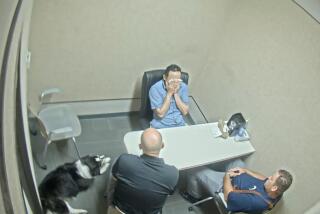2 Saw Peyer With ‘Claw Marks’ on Face : CHP Officer ‘Nervous’ to Gas Station Attendants on Night of Slaying
- Share via
Two women testified Monday that they saw “claw marks” and scratches on a “nervous” California Highway Patrol Officer Craig Peyer’s face on the December night that Cara Knott was killed near an Interstate 15 off-ramp.
Karen Anderson and Shirley Schwartz, both former employees of a service station on Kearny Villa Road, testified during the first day of Peyer’s preliminary hearing that they saw scratches and blood on the officer’s face when he pulled into the station Dec. 27, between 9:30 and 10 p.m., to buy gasoline for his patrol car.
Peyer, 37, is charged with the murder of Knott, who was a San Diego State University student.
Trained to Gouge
In other testimony Monday, Sanford Strong, who taught Knott self-defense about two years ago, testified that he trained the young woman to “go for the face” when attacked. Strong, who said he trained San Diego police officers for 20 years, said Knott, 20, was trained to use “fingernails, extended fingers, gouging of the eyes” if attacked.
Knott called her family at 8:30 p.m. Dec. 27 to tell them she was returning to her El Cajon home after visiting her boyfriend in Escondido, Samuel Knott, her father, testified Monday. Police said she was strangled that night between 9 and 10 p.m. on a bridge near Interstate 15 and Mercy Road before her body was thrown 75 feet into a dry creek bed. Her body was found about 8:30 a.m. the next day.
Anderson, who was among the first witnesses to testify at the preliminary hearing, said that, when Peyer walked up to the cashier’s booth to pay with a state credit card, she noticed “claw marks” on his nose and face.
“It looked like somebody had taken fingernails and claws . . . when I tried to mention something about it, he covered his face and turned away,” said Anderson, whose son-in-law is a San Diego policeman.
Schwartz, who was working with Anderson on the night of the killing, testified that she also noticed the scratches and coagulated blood on Peyer’s face.
“He looked a little disheveled. His hair was in disarray, and he looked very flushed,” Schwartz said. “He kept looking around, very nervous like. He seemed to be in a hurry.”
Both women said that Peyer told them that it had been “one hell of a night,” and Schwartz said that he left the station in a hurry and “squealed his tires on the way out.”
Joseph Riordan, a CHP officer who worked out of the same office as Peyer, testified that on the night of the incident he saw Peyer at the end of the shift and noticed blood on the back of his hands and face. Riordan said that Peyer claimed to have been injured when he fell by the CHP station’s gas pumps.
“As he came through the back door,” Riordan said, “he appeared to be a little ruffled and made the comment that he had fallen by the gas pumps.”
Riordan also testified that he had seen Peyer make a traffic stop between 9:30 and 9:45 p.m. that night. He said it involved twin brothers Jean Pierre and Robert Gulli, 17. Riordan said he was going to stop the Gullis’ car for having defective taillights, but it was Peyer who made the stop.
Ticket for Taillights
The two brothers, who also testified Monday, said they had left their sister’s house in Mira Mesa at 9:30 p.m. after watching a movie. About 10 minutes later, Peyer stopped them on California 163, near where it merges with Interstate 15, and gave Jean Pierre Gulli a ticket for having defective taillights, the brothers said.
The young men said Peyer appeared nervous and wrote Dec. 20 on the ticket, before changing it to Dec. 27. Jean Pierre Gulli testified that it took Peyer about 15 minutes to write the ticket. When he finished, Peyer wrote 10:30 p.m. on the citation and later changed it to 9:20 p.m., despite the fact that the stop was made at about 9:40 p.m., Gulli said.
“He (Peyer) was kind of nervous. . . . He seemed fidgety and had trouble finding what to say,” Robert Gulli said.
Samuel Knott, who testified early in the morning, struggled to maintain his composure as he talked about his frantic and fruitless efforts to persuade several police agencies to search for his daughter. Knott said he started getting worried an hour after his daughter called because she hadn’t arrived yet.
“I was getting anxious about Cara. About 10 minutes later, I jumped out of the chair and said, ‘I’ve got to go look for her,’ ” said Knott, who described his daughter as being careful and considerate. “Joyce (his wife) joined me, and we went to Penasquitos as fast as we could.”
Desperate Search by Family
Knott then described a desperate, all-night search by family members who drove up and down Interstates 8 and 15 looking for Cara Knott’s car, a white Volkswagen. He said that he went through one tank of gas before finally giving up his search at 4 a.m. Dec. 28.
Cara Knott’s car and body were discovered about 4 1/2 hours later. The young woman’s car was found parked at the bottom of the Mercy Road off-ramp by her brother-in-law, William Weick, who called police.
While conducting his search, Knott said, he tried unsuccessfully to persuade the San Diego County Sheriff’s Department, San Diego police and the CHP to take a missing-person report. At one point, he stopped a CHP car on Interstate 8, near Grossmont Shopping Center, and asked the officer to take a missing-person report.
“They refused, and it crushed me,” he said.
More to Read
Sign up for Essential California
The most important California stories and recommendations in your inbox every morning.
You may occasionally receive promotional content from the Los Angeles Times.










